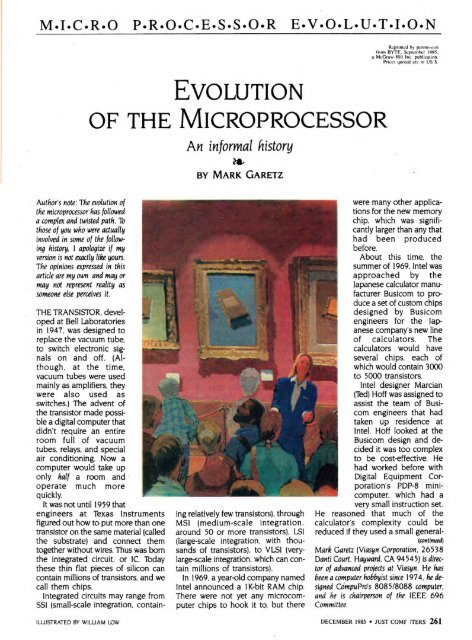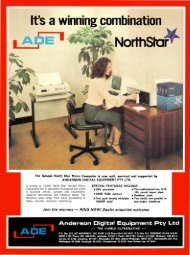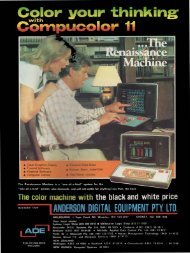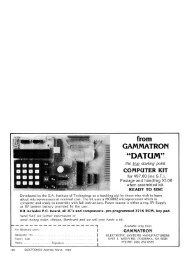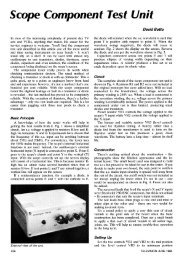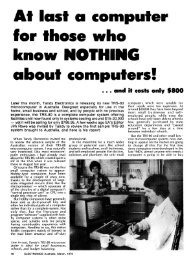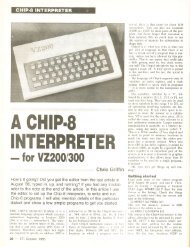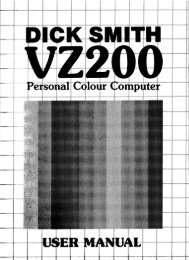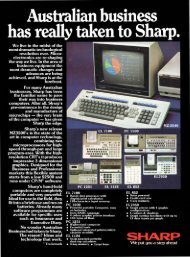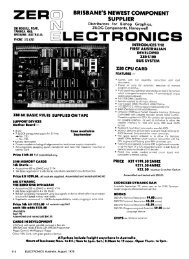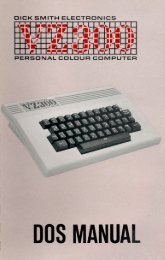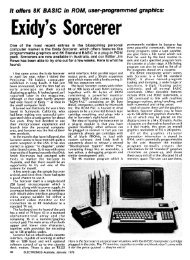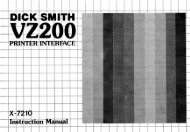History of Micro-Computers - The MESSUI Place
History of Micro-Computers - The MESSUI Place
History of Micro-Computers - The MESSUI Place
Create successful ePaper yourself
Turn your PDF publications into a flip-book with our unique Google optimized e-Paper software.
M•I•C•R•O P•R•O•C•E•S•S•O•R E•V•O•L•U•T•I.O•NEVOLUTIONOF THE MICROPROCESSORAn informal historyReprinted by permissionfrom BYTE, September 1985. .a McGraw-Hill Inc. publication.Prices quoted are in US S.BY MARK GARETZAuthor's note: <strong>The</strong> evolution <strong>of</strong>the microprocessor has followeda complex and twisted path. Tothose <strong>of</strong> you who were actuallyinvolved in some <strong>of</strong> the followinghistory, 1 apologize if myversion is not exactly like yours.<strong>The</strong> opinions expressed in thisarticle are my own and may ormay not represent reality assomeone else perceives it.THE TRANSISTOR, developedat Bell Laboratoriesin 1947, was designed toreplace the vacuum tube,to switch electronic signalson and <strong>of</strong>f. (Although,at the time,vacuum tubes were usedmainly as amplifiers, theywere also used asswitches.) <strong>The</strong> advent <strong>of</strong>the transistor made possiblea digital computer thatdidn't require an entireroom full <strong>of</strong> vacuumtubes, relays, and specialair conditioning. Now acomputer would take uponly half a room andoperate much morequickly.It was not until 1959 thatengineers at Texas Instrumentsfigured out how to put more than onetransistor on the same material (calledthe substrate) and connect themtogether without wires. Thus was bornthe integrated circuit, or IC. 'Ibdaythese thin flat pieces <strong>of</strong> silicon cancontain millions <strong>of</strong> transistors, and wecall them chips.Integrated circuits may range fromSSI (small-scale integration, contain-ing relatively few transistors), throughMSI (medium-scale integration,around 50 or more transistors), LSI(large-scale integration, with thousands<strong>of</strong> transistors), to VLSI (verylarge-scaleintegration, which can containmillions <strong>of</strong> transistors).In 1969, a year-old company namedIntel announced a 1K-bit RAM chip.<strong>The</strong>re were not yet any microcomputerchips to hook it to, but therewere many other applicationsfor the new memorychip, which was significantlylarger than any thathad been producedbefore.About this time, thesummer <strong>of</strong> 1969, Intel wasapproached by theJapanese calculator manufacturerBusicom to producea set <strong>of</strong> custom chipsdesigned by Busicomengineers for the Japanesecompany's new line<strong>of</strong> calculators. <strong>The</strong>calculators would haveseveral chips, each <strong>of</strong>which would contain 3000to 5000 transistors.Intel designer Marcian(led) H<strong>of</strong>f was assigned toassist the team <strong>of</strong> Busicomengineers that hadtaken up residence atIntel. H<strong>of</strong>f looked at theBusicom design and decidedit was too complexto be cost-effective. Hehad worked before withDigital Equipment Corporation'sPDP-8 minicomputer,which had avery small instruction set.He reasoned that much <strong>of</strong> thecalculator's complexity could bereduced if they used a small general-(continual)Mark Garetz (Viasyn Corporation, 26538Danti Court, Hayward, CA 94545) is director<strong>of</strong> advanced projects at Viasyn. He hasbeen a computer hobbyist since 1974, he designedCOmpuPro's 8085/8088 computer,and he is chairperson <strong>of</strong> the IEEE 696Committee.ILLUSTRATED BY WILLIAM LOW DECEMBER 1985 • JUST COMP JTERS 261
MICRO PROCESSOR EVOLUTIONpurpose processor. Such a design,using s<strong>of</strong>tware rather than electronicsto do the calculating, would greatly increasethe memory requirements <strong>of</strong>the calculator—but then, Intel was inthe memory business. H<strong>of</strong>f also realizedthat this processor could be putto other applications and he sold theidea to Intel management.<strong>The</strong> Busicom engineers were stillpursuing their original design whenH<strong>of</strong>f and his group started work ontheir alternative design. And althoughthe Busicom engineers had simplifiedtheir design, each chip still had over2000 transistors, and it would take 12chips to make a working calculator.H<strong>of</strong>f's team figured it would take 1900transistors to build their processor.H<strong>of</strong>f's general-purpose processordesign was chosen over the Busicomdesign, and Intel got a contract fromBusicom to produce the chip thatlater became known as the 4004.Actually making the chip proved tobe difficult until Federico Faggin (wholater founded. Zilog) joined Intel inearly 1970. He took the chip fromconcept to silicon in just nine months.At first Intel sold the 4004 exclusivelyto BusicOrn, but in the summer <strong>of</strong>1971, it gained the right to sell thechip set to other manufacturers.In November 1971 Intel advertisedthe 4004 as a four-bit processor thatperformed 60,000 operations per second.By February 1972 Intel had sold$85,000 worth <strong>of</strong> chip sets.THE BIRTH OF 8-BITSAt the same time the 4004 was beingdeveloped, CTC (Computer TechnologyCorporation, now Datapoint)asked both Intel and Texas Instrumentsto design LSI chips for a newintelligent terminal. Both companiesproposed an 8-bit general-purposeprocessor. Note the pattern developing:4-bits for calculators because theywork in BCD (binary-coded decimal)and 8-bits for terminals because theydeal with ASCII characters.Interestingly. CTC chose neithersolution; it built its terminal with standardlogic ICs. But TI and Intel wentahead with their projects anyway. TIeventually got a patent on its chip262 JUST COMPUTERS • DECEMBER 1985design and the project at Intel gavebirth to the 8008.<strong>The</strong> 8008. introduced in April 1972,was the first 8-bit microprocessor onthe market. It required at least 20 supportchips, but it had 45 instructionsthat it executed at 300,000 instructionsper second, and it adddresseda whopping I 6K bytes <strong>of</strong> memory.That was a lot <strong>of</strong> memory then, andthe 8008 was a considerable upgrade<strong>of</strong> the 4004.<strong>The</strong> documentation for the 4004and 8008 was cryptic (at least itseemed so to me; I didn't have a computerbackground at the time). <strong>The</strong>documentation assumed that youknew what everything was before youstarted reading it (a still-common failing<strong>of</strong> technical literature).Intel's primary goal with the 4004and 8008 was to replace "randomlogic'=-another way <strong>of</strong> saying "lots <strong>of</strong>SSI and MSI wired together:' Few peoplethought that these chips weresuitable for general-purpose computing.But a few visionaries were intriguedby the possibility <strong>of</strong> owninga computer that could actually dosomething. Mlle, computer kits hadbeen <strong>of</strong>fered previously, but theywere more useful for demonstratingcomputer principles than for doingcomputing tasks. <strong>The</strong> availability <strong>of</strong>the 8008 changed all that.In 1973 Scelbi Computer ConsultingInc. announced the first generalpurposemicrocomputer based on the8008. This was followed by theRGS-008 from RGS Electronics. <strong>The</strong>n,in July 1974, Radio-Electronics magazineintroduced Jonathan Titus's Mark-8 ina series <strong>of</strong> construction articles.Until then, all computer articles andads had been confined to amateurradiopublications. <strong>The</strong> Mark-8 wasthe first computer to hit a generalinterestelectronics magazine. <strong>The</strong>seearly microcomputers were still moredemonstration tools than useful, butthe small-computer revolution hadbegun.THE MIGHTY 8080In April 1974 Intel changed the waywe think about computers forever.<strong>The</strong>y announced the 8080, a signif-icant upgrade to the 8008 that requiredonly six support chips, had 75instructions and a tenfold increase inthroughput over the 8008, and addressed64K bytes <strong>of</strong> memory. (Noprogram, most people thought, couldever be that large!)<strong>The</strong> 8080 design was proposed byFaggin, but the design team washeaded by Masatoshi Shima, a youngengineer Intel had wooed away fromBusicom. Having learned from thelimitations <strong>of</strong> the 4004 and 8008, thedesigners made improvements tomake their new chip a truly usefulcomputing engine. <strong>The</strong> 8080, the firstmicroprocessor not aimed at logic replacement,looked much more like acomputer than anything that hadcome before it, and it was much easierto use from a hardware standpoint.<strong>The</strong> January 1975 Popular Electronicsmagazine featured the first in a series<strong>of</strong> construction articles on the Altair8800, a so-called "minicomputer"based on the 8080. <strong>The</strong> Altair was designedby MITS (<strong>Micro</strong> Instrumentationand Telemetry Systems), whichwas founded by Ed Roberts as a vehiclefor supporting his experiments inelectronics. <strong>The</strong> whole Altair kit, includingthe 8080 processor, motherboard,power supply, front panel withlots <strong>of</strong> lights, and 256 bytes (not 256Kbytes) <strong>of</strong> memory sold for $395.People thought it was a misprint.<strong>The</strong> 8080 chip, introduced just ninemonths before, had been selling for$360 all by itself. But MITS had madea special deal with Intel, and the price<strong>of</strong> the Altair was real. MITS sold morecomputers in the first day than it hadhoped to sell during the whole life <strong>of</strong>the product.<strong>The</strong> Altair played a significant rolein the success <strong>of</strong> the 8080, largelybecause programmers now had areason (and a good excuse) to writes<strong>of</strong>tware for a microcomputer chip.Also, the Altair's open bus architecture(an improved version <strong>of</strong> whichlater became the S-100/IEEE 696 bus)allowed people to begin making peripheralsfor the computer.One such peripheral was a disk controllerfrom Digital <strong>Micro</strong>systems thatfeatured the use <strong>of</strong> a new operating
MICRO PROCESSOR EVOLUTIONsystem for the 8080 calledCP/M (Control Program for<strong>Micro</strong>computers.) CP/M,brainchild <strong>of</strong> Naval PostgraduateSchool instructorGary Kildall, sold for $70and played a major role inthe success <strong>of</strong> the 8080 andits architecture. As a result,a large portion <strong>of</strong> themicrocomputer s<strong>of</strong>tware inuse today either runs onthe 8080 instruction set oris a direct upgrade <strong>of</strong> aproduct that did.THE MOTOROLA FAMILYIn response to the 8080'ssuccess, Motorola beganwork on the 6800, whichwas designed by ChuckPeddle. Motorola was thefirst company to introducea line <strong>of</strong> peripheral chipsdesigned specifically to gowith its microprocessor.<strong>The</strong>se chips includedparallel (6820) and serial(6850) I/O functions andmade the integration <strong>of</strong>these functions into asystem simple for systemdesigners.Motorola produced oneother significant "peripheral":a huge microprocessorapplications manual, biggerthan all other microprocessor documentationput together. And it wasalmost readable! Hackers and systemdesigners like myself rushed out andbought them at $25 each. True, themanual was still oriented toward logicreplacement, and you needed a minicomputerand expensive cross-assenibiersto write s<strong>of</strong>tware. No one hadyet written anything that really explainedthese new chips to peoplewho had no idea what they reallywere inside, or who had no computerexperience. But we read the Motorolamanual anyway. . . it was all we had.Chuck Peddle left Motorola to joinMOS Technology (not to be confusedwith Mostek, the subsidiary <strong>of</strong> UnitedTechnologies), a leader in thescientific-calculator-chip field. In June<strong>The</strong> cost <strong>of</strong> the popular 8080A microprocessorfrom 1975 to 1985. Note that in 1975only the 8080 microprocessor was available.or July 1975, MOS lbchnology ads appearedin the electronics trade journalsclaiming that the company wouldbe introducing and delivering a $20microprocessor at the WESCON showthat September. <strong>The</strong> so-called 6501was to be pin-for-pin plug-compatiblewith the Motorola 6800—you couldunplug the 6800 from a circuit boardand plug the 6501 right into the samesocket and it would work—althoughthe s<strong>of</strong>tware would also need changingbecause <strong>of</strong> differences in the architectureand instruction set. MOSwas also planning a version <strong>of</strong> thechip with the complex clock circuitryrequired by other microprocessorsbuilt in. This would be the 6502 andwould cost $25.<strong>The</strong> industry went into an uproar. Atthis time, Intel's 8080 and Motorola's6800 were both selling for$179 in single-piece quantity.I remember standing inthe lobby (actually a livingroom) <strong>of</strong> E-Mu Systemswith Scott Wedge and DaveRossum, who had just designedsome 8080s intotheir synthesizers. We weretalking with an Intel salespersonwho dismissed thead as a hoax. He said Intelhad assured him that MOScouldn't possibly do it atthat price, and that eitherthe ad was a publicity stuntor MOS lbchnology wasquoting the million-pieceprice. I said that there wasno reason that microprocessorchips wouldn't gothe same way as scientificcalculator chips had—originallyhundreds <strong>of</strong> dollars,now just a few dollars. Hesaid that the chips wouldnever go below $100.<strong>The</strong> salesperson's attitudewas nearly universal inSilicon Valley—but MOSTechnology was on the EastCoast. I called them up, andthey insisted that they wereserious and that yes, thatwas the single-piece price.I, and the rest <strong>of</strong> the valley,would have to wait for WESCON t<strong>of</strong>ind out.WESCON finally came and therewas the MOS Technology booth—butno chips. <strong>The</strong> company had discoveredwhen it got there that exhibitorsweren't allowed to sell anythingon the show floor. <strong>The</strong> chips,company representatives said, wereavailable in their hospitality suite in anearby hotel.I went to the suite that evening, andit was packed. <strong>The</strong> chips were in twolarge fishbowls. MOS also had hardwareand s<strong>of</strong>tware manuals availablefor $5 each. Ray Stevens, who ownedRGS Electronics and had designed theRGS-008, was tending bar. Steve Wozniak,was there, along with a lot <strong>of</strong>other people including Chuck Peddle,(continued)BERGMAN HAKE DESIGN INC DECEMBER 1985 • JUST COMPUTERS 263
MICRO PROCESSOR EVOLUTIONwho was happy to talk about his newprocessors.I sat down on the couch and lookedat the two manuals. <strong>The</strong>y were writtenin English and they made sense!MOS was also showing one more innovationin the suite that night—thefirst multifunction peripheral chips.<strong>The</strong> company had put RAM, ROM,timer, and I/O on one chip. One versionwas called the TIM (terminalinterfacemonitor) chip and containeda complete monitor for talkingto a serial terminal. <strong>The</strong> other was theKIM (keyboard-input monitor) chip,and it was designed into a microcomputerboard that had a keyboard, centralprocessor, display, ROM, RAM,and parallel I/O, and sold for $245. Itwas a complete system. No othermicroprocessor vendor had doneanything like this before. It wasimpressive.I went home that evening clutchingmy $25 6502 microprocessor and twomanuals. At the time I didn't realizeI would spend another $300 to makea working system, not counting theASR-3 3 Teletype I used as a terminal.That first day <strong>of</strong> WESCON, Intel andMotorola lowered the price on theirchips to $69.95. <strong>The</strong> revolution wasin full swing. <strong>The</strong> industry would neverbe the same.<strong>The</strong> 6501 was short-lived. Motorolasued MOS Technology charging thatChuck Peddle had stolen the technologyfrom Motorola and that the6501 infringed because it was plugcompatible.MOS 'Technology agreedto drop the 6501.However, the many computers thatwere developed around the 6502 arenow legend: MOS Technology's ownKIM-1, the Apple I and II, the Atarimodels, and the Commodore PETand VIC-20, among others. Actually,the future <strong>of</strong> the 6502 was still questionablewhen fledgling Apple ComputerInc. produced the Apple I. SteveWozniak put in a jumper connectionthat could be changed to allow the6800 to be used instead <strong>of</strong> the 6502.ENTER THE Z80Sometime in late 1975 or early 1976,Federico Faggin left Intel and formed264 JUST COMPUTERS • DECEMBER 1985his own company, Zilog Inc. He tookMasatoshi Shima with him. <strong>The</strong>ir goalwas to build a super 8080.In 1976, Zilog announced the Z80,a significantly enhanced 8080 that ranalmost all <strong>of</strong> the programs written forthe 8080. <strong>The</strong> company claimed itwould have parts that ran at 4 MHz,twice as fast as the 8080. In additionit had many more powerful instructions—atotal <strong>of</strong> 176. It sounded toogood to be true; the Z80 was treatedwith the same skepticism as the 6502had been.But the Z80 turned out to be real,and there actually were some 4-MHzparts available. <strong>The</strong> early ones said"Engineering Sample" on them andwere manufactured in Dallas, not inSilicon Valley. Mostek, a Z80 secondsource, was actually building the chipsfor Zilog. Nobody minded becauseeverybody wanted one for their owncomputer.Several Z80 cards for the S-100 buswere on the market shortly after thechip became available, and everybodyhad to have one. But even though theZ80 was a much more powerful chipthan the 8080 in terms <strong>of</strong> its instructionset, very few people were writings<strong>of</strong>tware to take advantage <strong>of</strong> theZ80's extra instructions. <strong>The</strong> reasonwas simple: <strong>The</strong> majority <strong>of</strong> themachines installed at that time were8080-based, and if you wrote codethat only ran on a Z80, your marketwould be 'considerably smaller. Thisproblem plagues the Z80 even today.However, designers stopped usingthe 8080 in new computers. <strong>The</strong> Z80was a far easier chip to use, requiringno support ICs and only a singlevoltagepower supply. And it wasmuch faster, even if you didn't use theextra instructions.<strong>The</strong> Z80 introduced one other newconcept to microcomputer chips:built-in support for refreshingdynamic RAMs. Dynamic RAMs havealways cost about four times less perbit than their static counterparts, andthat made th(pm very attractive to use.However. because you have to refreshthem (or else they forget their data),they are extremely difficult to use, andearly system designers viewed themwith some distrust. <strong>The</strong> Z80 gave thedesigner 90 percent <strong>of</strong> the solutionand made it possible to build systemsthat were significantly cheaper thanbefore. <strong>Computers</strong> such as RadioShack's original TRS-80, designed bySteve Leininger, took advantage <strong>of</strong>this fact.INTEL STRIKES BACKMeanwhile Intel had realized that the8080 needed upgrading. In 1976 Intelannounced the 8085. It had all the8080 instructions, plus a few more.But Zilog had taken Intel by surprise.<strong>The</strong> enhancements that the 8085 hadover the 8080 were nowhere near asextensive as those <strong>of</strong> the Z80. Froma purely hardware standpoint, the8085 was a much nicer chip than theZ80, but the Z80 had mass appealbecause it was faster. When introduced,the 8085 ran at 3 MHz, as opposedto the 4-MHz chip that Zilogwas already shipping. Intel had tocome up with something else—a16-bit processor seemed like theanswer.Sixteen-bit processors had beentried before. National Semiconductorhad started work on the IMP-I6 chipset as early as 1972. <strong>The</strong> companyreduced it to one chip called the Pace.and Bill Godbout Electronics announceda Pace-based computer, designedby George Morrow, in mid-1975. <strong>The</strong> unnamed system. a fullblown16-bit computer with RAM anda built-in cassette interface, was advertisedin the first issue <strong>of</strong> BYTE. <strong>The</strong>yactually built one, but it never got tomarket. Bill Godbout said that themarket wasn't ready for a 16-bit computer,and he was probably right.After all, the Altair was only a fewmonths old itself. Neither the Pacechip nor the computer was ever a hit.Other 16-bit chips included GeneralAutomation's LSI-16, a microprocessorversion <strong>of</strong> its SPC-16 minicomputer;DEC's-LSI-11, which was manufacturedby Western Digital and includedthe .PDP-11 instruction set;Western Digital's own WD-11, whichwas only one instruction differentfrom the LS1-11; General Instrument'sCP1600; and 'Texas Instruments'
MICRO PROCESSOR EVOLUTIONTMS9900, which went intotheir home computer, makingit the first mass-market16-bit computer.Interestingly, the firstliterature released by MOSTechnology on the 6502showed some little dashedlines where the 16-bit extensionsto their registerswould go in their 16-bit version<strong>of</strong> the 6502, the 6516.But the 6516 was nevermarketed, and the littledashed lines soon disappeared.<strong>The</strong> existence <strong>of</strong>such a part was rumoredfor years, but it never surfaced.Not until December1983 did the WesternDesign Center [not thesame as Western Digital] announcea 16-bit version <strong>of</strong>the 6502.Again, Intel neededsomething to compete withthe Z80. <strong>The</strong> companyfigured that most previous16-bit designs were flopsbecause they had no existings<strong>of</strong>tware base thatcould easily be migrated toit—they were all the firstmicroprocessor <strong>of</strong>feringsfrom their respective companies.But Intel had an edge: thegrowing base <strong>of</strong> 8080 s<strong>of</strong>tware.<strong>The</strong> company decidedthat its 16-bit processor would be adirect enhancement <strong>of</strong> the 8080. In1976 Intel started work on the 8086.Unfortunately, the designers did notpreserve direct compatibilty with8080 code, but at least each 8080register had its 8086 counterpart,which made 8080-to-8086 code translatorspossible and gave programmersa familiar starting point. This was a bigfactor in the success <strong>of</strong> the 8086,which was announced to the world in1978.<strong>The</strong>n someone at Intel had an inspiration.Why not make the hardwarealmost as easy to migrate as the s<strong>of</strong>tware?Thus was born the 8088. <strong>The</strong>8088 is an 8086 on the inside but has<strong>The</strong> cost <strong>of</strong> 64K bytes <strong>of</strong> RAM from1975 to 1985, as found on the pages <strong>of</strong> BYTEmagazine. Prices shown am for 512 <strong>of</strong> the1-kilobit 5260 chip, 256 <strong>of</strong> the 2-kilobitMM52132 chip, 32 <strong>of</strong> the 2K-byte 4116 chip, and8 <strong>of</strong> the 8K-byte 4164 chip.an 8-bit data bus on the outside.When the processor wants to fetch 16bits <strong>of</strong> data, it first gets 1 byte, thenthe second. <strong>The</strong> programmer doesn'thave to worry about it, it all happensautomatically in the hardware. <strong>The</strong> actualsignals coming out <strong>of</strong> the 8088look similar to the 8085, a chip thatdesigners were already familiar with.Thus, it was easy to upgrade an existing8-bit design to 16 bits.You might think that by doing thisthe processor would run at half itspotential. But Intel had been cleverwhen they designed the 8086. Internallyit consisted <strong>of</strong> two different butlinked processors. One was the executionunit, the part that actually pro-cesses the data or executesthe instructions. <strong>The</strong> otherwas called the bus-interfaceunit (BIU). <strong>The</strong> BIU handlesall communications withthe outside world and is incharge <strong>of</strong> generating addressesand storing andretrieving data from thesystem. Inside the BIU is aqueue. While the executionunit is busy crunching data,the BIU is out on the busgetting the next instructionand putting it in the queue.<strong>The</strong> 8086 BIU can stay upto 6 bytes ahead <strong>of</strong> the executionunit by keepingthose bytes in its queue.Because <strong>of</strong> the queue, the8088 performance only suffersan average <strong>of</strong> 20 percentcompared to an 8086.(See "Benchmarking theIntel 8086 and 8088" byGregg Williams, July 1983BYTE, page 147.) <strong>The</strong> 8086/8088 processors were thefirst to use a queue mechanism.Intel also introduced anothernew concept with its8086 family—coprocessing.<strong>The</strong> idea was to hang anotherprocessor right onthe bus <strong>of</strong> the main processorto extend its. functions.<strong>The</strong> most significant<strong>of</strong> these coprocessors wasthe 8087, a math coprocessor thatadded a whole set <strong>of</strong> floating-point instructionsto the 8086/8088. Since the8087 was built solely to do math, itcould do so very quickly.THE MC68000In 1977, designers at Motorola wereworking on a new processor for the16-bit market but vowing to keep it 32bits internally. <strong>The</strong>y also wanted toeliminate any special-purpose instructionsand allow the processor toperform all operations, on all registers,on all data types, and in alladdressing modes. This is calledorthogonality. Programmers like(continued)BERGMAN HAKE DESIGN INC DECEMBER 1985 • JUST COMPUTERS 265
MICRO PROCESSOR EVOLUTIONorthogonality because it means theydon't have to memorize a bunch <strong>of</strong>exceptions to the instruction set. <strong>The</strong>fruit <strong>of</strong> Motorola's effort was the 1979release <strong>of</strong> the MC68000.<strong>The</strong> MC68000 is one <strong>of</strong> those chipsthat some people love and othershate. <strong>The</strong>re is very little middleground. Compared to the 8086/8088,it required a massive s<strong>of</strong>tware effortto get it to do anything. But UNIX wasbecoming popular, and the 68000looked like a good UNIX machine. Anumber <strong>of</strong> 68000-based UNIX machineswere announced, althoughhardly any <strong>of</strong> them were successful.Motorola also announced the68008, an 8-bit-bus version <strong>of</strong> the68000, similar in concept to the 8088.However, the 68000 had no real queuing,and that meant that the 68008ran half as fast as the 68000. Unfortunately,this made the 8088 lookeven better.Internally, the 68000 was a microcodedchip, which means that internalfunctional elements are generalpurpose.A ROM (which contains themicrocode) controls what the chipdoes. <strong>The</strong> processor's response toeach instruction is controlled by theROM. If an instruction doesn't do theright thing, you can usually fix it in theROM and, within limits, you can evenchange the instruction 'set <strong>of</strong> themicroprocessor if you want to. (IBM'sadd-in processor for the XT/370 isessentially a 68000 with custommicrocode.)Up until this time, all other processorswere generally random-logicdesigns that had a little bit <strong>of</strong> circuitryto perform each specialized functionwithin the central proceSsor. <strong>The</strong>reare advantages and disadvantages toboth types <strong>of</strong> microprocessordesign—microcoding <strong>of</strong>fers flexibilityat the expense <strong>of</strong> speed, while arandom-logic design <strong>of</strong>fers speed atthe expense <strong>of</strong> flexibility. It is also difficultto fix errors in a random-logicdesign—especially when the designer<strong>of</strong> the chip leaves the company.At Zilog, for example, MasatoshiShima had begun work on a 16-bitprocessor, the Z8000, using randomlogic. Random logic worked fine forthe 8080 and Z80 but, in hindsight,it is unfortunate that Shima designedthe Z8000 that way. After the firstZ8000 silicon was produced, butbefore his team had had worked allthe bugs out <strong>of</strong> the chip, Shima left ,Zilog to return to Intel. Zilog never didget all the bugs out <strong>of</strong> the Z8000. Inaddition, Zilog had set a standard byallowing the Z80 to run all the s<strong>of</strong>twarefor the previous-generation8080. Unfortunately, the companydidn't follow its own standard andmade the 28000 completely differentfrom the Z80. Zilog was trying to puta minicomputer on a chip and, unfortunately,it didn't do a very good job<strong>of</strong> it. <strong>The</strong> Z8000's lack <strong>of</strong> a similar instructionset to the Z80, its built-inbugs, and its sacrifice in instructionpower due to its random-logic natureall played a great role in keeping theZ8000 from becoming successful.In 1981, National Semiconductormade a second attempt at the 16-bitmarket with the 16032. <strong>The</strong> 16032was to be a 32-bit (internal data bus)microprocessor with a 16-bit externalbus. Since Motorola had never beenable to produce their promised mathcoprocessor, and Intel's 8087 so farcouldn't break the 5-MHz speed barrier,everyone was impressed whenNational announced its math coprocessor,which would run at 10 MHz,giving it twice the performance <strong>of</strong>Intel's 8087.Unfortunately, National became thefirst microprocessor company to shipall its peripheral chips 100 percentfunctional before the processor wasavailable. Today the 16032 still has afew bugs in it. But programmers likeits instruction set, which remindsthem <strong>of</strong> a VAX (a series <strong>of</strong> highperformanceDEC superminicomputers).Because the VAX has been sosuccessful as an engine for runningUNIX, the 16032 may be a naturalsuccessor as the base for a UNIXcomputer. <strong>The</strong>re may be some life leftin it yet.In 1982, Intel one-upped the semiconductorindustry again. <strong>The</strong>y announcedthe iAPX 286. This newproduct was a vastly upgraded 8086architecture that included built-in vir-tual memory management and manyother features designed expressly forsupporting a multitasking, multiuserenvironment. It has a mode that runsall 8086 code directly, and Intel hassignificantly sped up its throughput.Also, true built-in memory managementis something that no othermicroprocessor has to this day. <strong>The</strong>main advantage to having memorymanagement built in is that it canwork much 'faster than processors thatrequire external memory managers.<strong>The</strong> IBM PC AT's use <strong>of</strong> the 80286 hasensured the success <strong>of</strong> this processorfor at least the next few years.32-BIT CHIPSIn spite <strong>of</strong> problems with the 16032,National Semiconductor was the firstcompany to announce and ship a fullblown32-bit microprocessor. <strong>The</strong>32032, which used to be the 16032,is code-compatible with the 32016.It's still early to tell how the 32032 willfare, but the popularity <strong>of</strong> UNIX willprobably be a major factor in its success,if indeed all the projections <strong>of</strong>the 32000 family being the ideal UNIXengine are true.Motorola is now sampling its full32-bit extension to the 68000, the68020, which looks promising. It hasone new feature that will probably getit into lots <strong>of</strong> designs early. Rememberthat the 8088 was successful becauseit allowed an easy migration path dueto its 8-bit external data bus. <strong>The</strong>68020 lets you dynamically choosethe bus size you want-8, 16, or 32bits. Supposedly, it is able to run all68000 code, and it's fast. One <strong>of</strong> thethings that gives it great speed is itscache—the logical extension <strong>of</strong> thequeue used in the 8086/8088/80286processors.<strong>The</strong> cache in the 68020 is 256 bytesdeep and works a little differentlyfrom a queue. If a jump occurs to apoint in the queue, the queue isflushed and reloaded. But the cachelooks just like memory, so a jump toa point in the cache would not causethe cache, to be dumped and reloaded.If loops are small enough,they can execute directly from thecache. <strong>The</strong> advantage is that the pro-266 JUST COMPUTERS • DECEMBER 1985
MICRO PROCESSOR EVOLUTIONcessor can access thecache much faster than itcan access externalmemory, so programs runfaster if they stay mostly inthe cache. As with the32032, its still early to tellwhat the eventual success<strong>of</strong> the 68020 will be.National has alsoannounced the 32132 (notyet available), which is tohave multiple caches andsomething the companycalls a look-aside buffer.Zilog had announced aproduct called the Z800, a16-bit upgrade to the Z80that was to be code-compatiblewith it. <strong>The</strong> companywas never able to produceworking silicon, however.Instead, it is trying toget the Z80 to work at 10MHz. Zilog has also announcedthe Z80000, a32-bit version <strong>of</strong> the Z8000that I call the "kitchen-sinkprocessor" because it willhave everything, includingcode compatibility with theZ8000, which is the rightidea but the wrong processor.Intel has been talking forsome time about the coming80386, its 32-bit version<strong>of</strong> the 80286, but to date it hasn't releasedany hard data on it. Intel saidit will be 80286-compatible, and thatprobably means IBM will use it.FASTER OR SMARTER?I can't end my discussion <strong>of</strong> microprocessorswithout mentioning a fewbizarre approaches. <strong>The</strong>re is still adebate raging on whether microprocessorinstruction sets should evolvetoward more complex and high-levelinstructions, or whether they shouldbe getting much simpler but muchfaster. So far, high-level instructionsets have not been winners. One illfatedattempt was Western Digital'sPascal <strong>Micro</strong>engine, which executedPascal pseudocode (the output <strong>of</strong> allloyal Pascal compilers) directly.<strong>The</strong> cost <strong>of</strong> an 8-inch single-sided double-densityfloppy-disk drive from 1977 to 1985. Note thatsuch drives were not available in 1975 and 1976.Unfortunately, Pascal compilers thatput out native 8080 code beat ithandily.Similar in concept is the new FORTHprocessor from Novix, developedunder the direction <strong>of</strong> FORTH inventorCharles Moore. Instead <strong>of</strong> executingthe output <strong>of</strong> a compilerdirectly, this FORTH chip runsthreaded FORTH code directly—its instructionset is FORTH. It's supposedto be very fast, and if you like FORTHit's great.<strong>The</strong> FORTH engine is a custom version<strong>of</strong> a chip from National CashRegister called the NCR 32. It is amicrocode-executing 32-bit engine ontwo chips; a third chip is required tocontain the microcode. Essentiallyyou can "roll your own" instructionset, which is what thedevelopers <strong>of</strong> the FORTHengine did. This techniqueopens up a whole realm <strong>of</strong>possibilities, such as beingable to emulate differentcomputers on the fly bydownloading different instructionsets. <strong>The</strong> speed atwhich this will be accomplished,however, will belimited by the fact thatmicrocoding is hard work.<strong>The</strong> Intel iAPX 432, probablythe first 32-bit microprocessoravailable, wasdesigned with very-highlevelinstructions to supportthe U.S. Department <strong>of</strong>Defense's Ada language.Opposite the high-levelinstructions' team are thosewho think that a small set<strong>of</strong> simple but extremely fastinstructions can outperformlarge and complex (slow) instructions.Such are theRISC (reduced instructionset computer) fans. A RISCmachine was successfullyimplemented in silicon atBerkeley, amazingly on thefirst pass. <strong>The</strong>y are currentlyworking on speeding upthe chip, which has a 32-bit architecture. Hewlett-Packard is also rumored tobe working on several RISC machines.Last is a unique device just aboutto be sampled from INMOS called the11-ansputer (see "<strong>The</strong> 11-ansputer" byPaul Walker, May BYTE, page 219). Itis designed to perform parallel processing.It will take many more years<strong>of</strong> s<strong>of</strong>tware development and sophisticationto take full advantage <strong>of</strong> theTtansputer, but the possibilities arefascinating.Meanwhile, a 4004 microprocessorstill controls a traffic light near my <strong>of</strong>fice.It tends to put all the whizzy newthings in perspective, doesn't it? ■ACKNOWLEDGMENTSI would. like to thank Rebecca Wallo <strong>of</strong>Intel and Jim Farrell <strong>of</strong> Motorola for providingfacts and figures for this article.BERGMAN HAKE DESIGN INC DECEMBER 1985 • JUST COMPUTERS 267
AReprinted h■ permission fromBYTE. September 1985.a McGra,v-Hill Inc. publication.Prices quoted arc in CS S.MICROCOMPUT1NGTIMELINEPHOTOGRAPHEDBY PAUL AVISULCOVER STORY IS ON THE MARK-8,Radio EDON LANCASTER TELLSHow CalculatorBUILD THE MARK-8IC's WorkYour Personal MinicomputerNEW FM CIRCUITSFor Precise TuningDESIGN YOUR OWNDirect-CoupledTransistor AmplifierWHAT YOU NEED'In Hi-Fi Test GeaWORKINGWITH SCR'sAn ExperiGuidePLUSAppliance -EquipmeJackStepR-E's/9 RADIO-ELECTRONICS'What follows is a modest and, we hope, correct timeline <strong>of</strong> personal computing.If the number <strong>of</strong> entries per year is any indication, then the mostactive years <strong>of</strong> personal computing were 1975, 1976, and 1977 and 1982,1983, and 1984.Although the roots <strong>of</strong> personal computing go back further, the excitementreally started in January 1975, with the publication <strong>of</strong> Popular Electronics'cover story on the Altair 8800. A slogan printed on the cover<strong>of</strong> the first three issues <strong>of</strong> BYTE said it all: "<strong>Computers</strong>—<strong>The</strong> World's GreatestToy." <strong>The</strong> slogan expressed the ideal that lured many, but few <strong>of</strong> us hadthe stamina and consuming fanaticism needed to make it happen: you hadto design and build everything yourself, hardware and s<strong>of</strong>tware. Most<strong>of</strong> you also had to learn electronics, mathematics, and the art <strong>of</strong> decipheringarcane, poorly written spec sheets—the phrase "by your bootstraps" tookon new meaning.By 1978, things were different: you could buy microcomputers and theywould usually work, but it wasn't the same. Prior to 1978, the excitementwas in saying "Look, my design works!" But when you took it for grantedthat it worked, the question became "What can you do with it?": however,the answer was "Not all that much." Most systems lackeda disk drive and had 32K bytes <strong>of</strong> memory or less. <strong>The</strong> yearsbetween 1978 and 1982 were slow, evolutionary years—not too exciting, but necessary.By late 1981, the industry was poised for growth, andIBM's introduction into the marketplace catalyzed that growthinto a bumpy, breathtaking ride that shows no signs <strong>of</strong> slowing(though it did take about a year to get started, that is,to produce a significant number <strong>of</strong> IBM-related products), Personalcomputers finally could perform and were affordableenough to be used by people who weren't just hobbyists: thatprogress continues to build as computers become simultaneouslycheaper and more capable.BYTE has kept a close watch on the computer industry'sgrowth, and we felt the need to annotate this timeline. Whendates have been difficult to pinpoint, we've approximated them.In general, it has been an active and interesting first ten years.—Gregg Williams and Mark Welch36 JUST COMPUTERS • DECEMBER 1985
1948<strong>The</strong> Transistoris inventedatBellIndustriesPre-19751948 John Bardeen, Walter Brattain, and WilliamShockley <strong>of</strong> Bell Laboratories invent the transistor.1959 Texas Instruments unveils the first integratedcircuit.1964 John G. Kemeny and Thomas E. Kurtzdevelop the BASIC programming language atDartmouth College.Digital Equipment Corp. advertises the PDP-8minicomputer, which, at $16,200, is "a full,general-purpose computer that scientists canafforti—but it gets personal."1979 OCTOBER Scientific American publishesMartin Gardner's first "Mathematical Recreations"column on John Conway's game <strong>of</strong> Life.Intel Corp. puts the 4-bit 4004 microprocessoron a single chip. Its initial price is $200.NOVEMBER Intel Corp. introduces the 8008,their first 8-bit microprocessor.Nolan Bushnell founds Atari and ships the Pongvideo game.Scelbi Computer Consulting <strong>of</strong>fers the8008-based Scelb1-8H computer kit ($565 with 1Kbyte <strong>of</strong> memory).Intel Corp. announces the improved 80808-bit microprocessor.SEPTEMBER Radio-Electronics magazinepublishes Don Lancaster's TVT-1 computerterminal project.1974 Brian W. Kernighan and Dennis M. Ritchiedevelop the C programming language.Gary Kildall develops the CPIMoperating system.Radio-Electronics' cover story is "Build theMark-8: Your Personal Minicomputer,"EPTEMBt Creative Computing magazinefounded.Announcinga new era<strong>of</strong> integratedelectronicsA microprognunmable=Putson a chip!NOVEMBER 19, INTEL'S FIRST AD FOR THE 4004 MICROPROCESSOR IN ELECTRONIC NEWS.DECEMBER 1985 • JUST COMPUTERS 37
Zilog Inc. develops the Z80microprocessor, whose instruction set is asuperset <strong>of</strong> the 8080's,Carl Helmers founds Experimenters'Computer System (ECS), which lasts for fiveissues before he moves to BYTE.Popular Electronics' cover story is"World's First Minicomputer Kit to RivalCommercial Models...Altair 8800." <strong>The</strong> Altair8800 kit, with an Intel 8080 microprocessor, 256bytes <strong>of</strong> memory, and a toggle-switch-and-LEDfront panel, sells for $395.MAF Homebrew Computer Club founded.MA'. Amateur Computer Group <strong>of</strong> New Jerseyfounded.IMS International announces the IMSAIcomputer, which is essentially an improved clone<strong>of</strong> the Altair 8800.SUMML MOS Technology announces theMC6501 at $20 and the MC6502 at $25; at thispoint, the 8080 costs about $150.MITS (the company that sells the Altair8800) announces 4K-byte and 8K-byte BASIC(from <strong>Micro</strong>s<strong>of</strong>t's founders Bill Gates and PaulAllen) for $350 and $500, respectively ($60 and$75 for purchasers <strong>of</strong> complete Altair systems).Dennis Allison publishes Tiny BASIC—laterenhanced by many, including Tom Pittman andLi-Chen Wang.Sphere Corp. <strong>of</strong>fers the Sphere I computerkit (6800, 4K bytes <strong>of</strong> RAM, ROM monitor,keyboard, video interface, for $6501.MOS Technology announces the KIM-1microcomputer, an assembled single-boardcomputer (6502, 1K byte <strong>of</strong> RAM, 2K-byte monitorin ROM, keypad, LED readout, cassette and serialinterfaces, for $245).IBM announces the IBM 5100, thefirst briefcase-size computer (with BASIC, 16Kbytes, and a tape cartridge storage system, forabout $9000.iE Ofiua BYTE publishes its first issue.Godbout advertises the Pace kit inBYTE with "7 segment readouts for easy octaldebugging."Southwest Technical Products Co.advertises the M6800 computer kit (6800, serialinterface to terminal, monitor in ROM, for $450).Unlike the Altair, it has no front-panel switches!MITS unveils the Altair 680 kit (6800,1K byte <strong>of</strong> RAM, serial interface, for $293).<strong>Micro</strong>computer Associates Inc. <strong>of</strong>fersthe JOLT kit (6502, 512 bytes <strong>of</strong> RAM, serialinterface to terminal, monitor in ROM, for S249).Robert Tinney's first BYTE cover.JANUI‘' Dr. Dobb's Journal <strong>of</strong> ComputerCalisthenics and Orthodontia (Running LightWithout Oyerbyte), a homebrew hardware ands<strong>of</strong>tware magazine, publishes its first issue.MAR(' David Bunnell <strong>of</strong> MITS organizes the FirstWorld Altair Computer Convention in Albuquerque,New Mexico.SPRING Texas Instruments announces itsTMS9000, the first 16-bit microprocessor.APR). Apple Computer Inc, formed.ERII Cromemco Inc. advertises the Dazzler TVinterface board—the first color display for amicrocomputer.Keuffel and Esser (K&E) ceases itsproduction <strong>of</strong> slide rules and donates its last oneto the Smithsonian.SwTPC M6800 ad promises "SOFTWARE—<strong>The</strong> flood is near. Editor and assembler nowavailable, BASIC and more games right away.Yours for the cost <strong>of</strong> copying. WE DON'T SELLSOFTWARE—WE GIVE IT TO YOU. ENJOY IT,COPY IT, WE WON'T COMPLAIN..."Scelbi releases SCELBAL, a BASIC-likelanguage for $49 (includes source); it runs in 8Kbytes <strong>of</strong> memory or more.AUGUST First floppy-disk-drive ad in BYTE (iCOMFrugal Floppy, 8-inch, for $1195 [single quantity]).John Dilkes organizes the PersonalComputing Festival in Atlantic City; it is the firstmicrocomputer show <strong>of</strong> national scope.First portable computer: STM Systems'"BABY!" (6502, 2K bytes <strong>of</strong> RAM, bootstrapprogram in ROM, system s<strong>of</strong>tware on tape, for$850 assembled).Steve Wozniak proposes that Hewlett-Packard Co. create a personal computer; SteveJobs proposes the same to Atari—both arerejected,SEPTE'' Ohio Scientific Instrumentsadvertises OSI 400 (6502, 6572, or 6800, paralleland serial ports, 1K byte <strong>of</strong> RAM, 512 bytes <strong>of</strong>PROM, kit prices—$140 and up).Cromemco Inc. <strong>of</strong>fers 4-MHz Z80 boardfor Altairs and other S-100 systems ($395 kit, witha monitor program on paper tape).OCTOBE PolyMorphic Systems advertises theS-100—based POLY 88 (8080A, 512 bytes <strong>of</strong> RAM,video/keyboard interface board, 1K byte <strong>of</strong> ROM,cassette interface, for $685 in kit form).Cellar).,-t1 Steve Ciarcia's first article (not CircuitDE,,..-3ER Processor Technology advertises theSot computer (8080, S-100 bus, 1K byte <strong>of</strong> RAM,1K byte <strong>of</strong> PROM, 1K byte <strong>of</strong> video RAM,keyboard, cassette, serial, and parallel interfaces,BASIC-5 on cassette—kit, $995; with dual 8-inchdrives and operating system, $1895; an assemblylanguageTREK-80 game, PT 8K BASIC, and 8080FOCAL are also available). <strong>The</strong> machine wasinvented by Lee Felsenstein.MBMichael Shrayer writes ElectricPencil, the first popular word-processing programfor microcomputers.DECEMBER Shugart announces its 51/4-inch"minifloppy" disk drive for $390.FALLTHE SPHERE 1 COMPUTER KIT38 JUST COMPUTERS • DECEMBER 1985
,A1,1110154 1•11,••V.,tcfritrtAr,Which <strong>Micro</strong>processorfor youasscUeyCtthe small systems journalnZytcbe Your memoryAPRIL 1976APPLE IBOARDAssembling Your Assembler:an YOU use these SURPLUSKEYBOARDS?(You bet you can!)COMPUTERS-the triprhrs (;rites,SEEMBER 197r BYTE'S DEBUTCeiriPARI_iCOM's Frugal Floppy.At 5995, your microprocessor's best friend.Mncr ROD000? 161iBi iT T16BIT "WM. Wt. NIMae tsis.SAS *AU On. -•VOCOMPOSSI 141 POWs - S WASSfie• 5.771. SISSOM*111.sMan OS SIM SSW...+6. MUIR 301401AIMMM. 411,1441.1.1.4.4.1 as.OKA WM, .0.0721, TAAI 01, • ,A A WEE AAA. AAAA,A•11, Ail II IAA, A*,tessesosser.esso;„iqem.s. '"'"sstls,"tosss.sass tskst.•• • fss:r 'Sf!fasons.04• sAI MACHOS'S• CA=A,AAAA:■=r.gyPow..tesSassi Pmts.wow. ioasoome FOOS.sethram.t.rs=1Z.c.a. assesss.......SysypieNAVA.. A,'',110••• fAAAA th•• MICROPERIPHERALSZarsuloASSAII::=1•10 WO•• sass. S• st.ss.s....• Ks W.*,JUNE 1976 SWTPC SOFTWARE ADAUGUST 1976 ICOM'S FRUGAL FLOPPY ADGODBOUT PACE KIT ADPOPULAR ELECTRONICS'FEATURES THE ALTAIR 8800HOW TO "READ" FM TUNER SPECIFICATIONSPopular Electronics05 ZAVIAA, 145354 75,51.7Y 15PROJECT BREAKTHROUGH!likvld's First Minicomputer Kitto R hal Commercial Models..."ALTAIR MOO"SAVE OVER $1000THE KIM-1JANUARY 1975 THE ALTAIR 8800e An Under -$90 SclentlIk Calculator ProjectCCD's—TV Campers Tube Successor?e ThyrIstor -Controlled Phot<strong>of</strong>lashes:TEST REPORTS,locimms 200 Speaker SystemRoarer RT-1011 Open 4toni RecorderIran Diamond 40 CO Au
pOhio Scientific Instruments <strong>of</strong>fers thefirst microcomputer with <strong>Micro</strong>s<strong>of</strong>t Ifloating-pointiBASIC in ROM: it is also the fastest,Kilobaud (which later changed its nameto <strong>Micro</strong>computing) publishes its first issue.Computer Shack (which later changesIts name to ComputerLand) opens its first store.i ,. Jim Warren organizes the let West CoastComputer Fain) in San Francisco <strong>The</strong> Apple II andCommodore PET (see below) are introduced there.APRIL Commodore Business Machines Inc. unveilsits PET computer (6502. 4K bytes <strong>of</strong> RAM, 14Kbytes <strong>of</strong> ROM, keyboard, display, tape drive, for$595 assembled). Its all-in-one packaging and 8Kbytes <strong>of</strong> <strong>Micro</strong>s<strong>of</strong>t BASIC were innovative. Itscelculetor-ped keyboard was (unfortunately) theprecedent for later microcomputers.Camp Retupmoc, the first weeklongcomputer camp, is held in Terre Haute, Incliane,Apple Computer Inc, runs its first ad inBYTE (6502, 4K bytes <strong>of</strong> RAM, Integer ROM andmonitor in 16K bytes <strong>of</strong> ROM, keyboard, cassetteinterface, 8-slot motherboard, game paddles,graphics text interface to color display, for $1298;with maximum 48K bytes <strong>of</strong> RAM, $2638).SwTPC <strong>of</strong>fers n two-drive 6800 systemwith terminal. monitor, and computer for $1999.<strong>Micro</strong>computers become more widelyavailable 'service does, tool through Radio Shack:their TRS.80 Model I (Z80, 4K bytes <strong>of</strong> RAM, 4Kbytes <strong>of</strong> ROM ;Level I BASIC), keyboard, display,cassette interlace, and recorder) costs $599.95.North Star <strong>Computers</strong> announces itsHorizon computer (Z80A, 16K bytes <strong>of</strong> RAM, oneY.-inch floppy drive, 12-slot 5100 motherboard,serial interface to terminal, $1599 kit, $1999assembled!.Ciarcia's Circuit Cellar begins.FEBRUARY Ward Christensen and Randy Seosscreate the Computerized Hobbyist Bulletin BoardSystem, the first major CBBS running on amicrocomputer.Kathe and Dan Spraklen s Sargon winsthe 2nd West Coast Computer Faire chesstournament. (<strong>The</strong> 3rd takes place in Los Angeles inNovember.)P <strong>The</strong> Digital Group advertises the Bytemaster,a sewing-machine-size computer housing adisplay, keyboard, and disk drive. Never verypopular. it predates the Osborne 1,MAY Ken Bowles first describes the machineindependent UCSD Pascal languagefoperatingsystem in BYTE..Ic Exidy unveils the Sorcerer (180, 8K bytes <strong>of</strong>RAM, 12K bytes <strong>of</strong> ROM, keyboard, parallel, serial,and cassette interfaces, $895). <strong>The</strong> machine'sinnovations are its user-definable characters andits optional s<strong>of</strong>tware on plug-in ROM cartridges.<strong>Micro</strong>Pro International unveils WordMaster, the precursor <strong>of</strong> the ubiquitous WlortiStarword processor (which appears in mid-19791.Epson America Inc, announces theMX-80 dot-matrix printer; its high performanceand low price stun competitors and forcecompetition and lower prices in the printer market.Atari announces the Atari 400 and800 <strong>The</strong> 800 has a full keyboard, 8K byte <strong>of</strong>RAM (expandable to 48K via memory slots), twoROM cartridge slots, and custom graphics andsound chips designed by Jay Miner (who laterdesigns the Amiga custom chips); it originallycosts $1000, <strong>The</strong> machines do not becomeavailable until late 1979. A derivative machine(now costing under $100) is still on the market,and Its graphics are unsurpassed in the 8-bit market.SPRING CompuServe, a telecommunicationsfounded,MA: Dan Bricklin and Bob Franksttm <strong>of</strong> S<strong>of</strong>twareArts Inc, show the VisiCalc spreadsheet programat the 4th littlest Coast Computer Fairs. Thisprogram caused many to take microcomputersseriously for the first time VisiCalc was originallymarketed by Personal S<strong>of</strong>tware (which laterchanged its name to VisiCorpl, but S<strong>of</strong>tware Artsregained the rights to VisiCalc in September 1984.(VisiCorp merged with Paladin in late 1984, andS<strong>of</strong>tware Arts merged with Lotus in April 1985.)MAY <strong>The</strong> FORTH Interest Group distributes O)first public-domain version <strong>of</strong> fig-FORTH, whichbegins the eventual widespread availability <strong>of</strong> thelanguage on microcomputers."')E <strong>The</strong> Source telecommunications utilityfounded,Texas Instruments unveils the TI-99 4,which originally sold for $1150 (which included acolor monitor). <strong>The</strong> machine is slow (even thoughit uses TI's TMS9900 16-bit processor). thebutton-style keyboard is oddly laid out. and TIdiscouraged third-party s<strong>of</strong>tware. <strong>The</strong> revisedT1-99 4A solved some problems, but TI finallydiscontinued the computer in late 1583; itscloseout price went as low as $50.S!'"" Magic Wand becomes the first seriouscompetitor to WordStar; it was just as powerfuland easier to useSUMMER Wayne Ratliff develops the Vulcandatabase program lAshton:Tate later markets it asdBASE 11),You've /tot run out <strong>of</strong> CIECIAinfor nut owning 4 pervonal computer40 JUST COMPUTERS • DECEMBER 1985
VICOSFARILM/Vt WI:AM 31). il)t I ftstrti tWistMM.'S 14:7 1.11.1.N.13 SIXCARPGiniftlatttiRETOPRO4WM 0$ ATsknw r).y4: 2f.nitehe t, itak, t5; July 11.11JUNE 19 ? THE FIRST COMPUTER CAMPTHE TI-95'Pk:xi:0,14R 19 THE EPSON MX-80DECEf';F7 THE ATARI 800 THE ATARI 400THE BYTEMASTERTHE TRS-80 MODELTHE COMMODORE PETDECEMBER 1985 • JUST COMPUTERS 41
1980FEBRUARY 0 THE SINCLAIR ZX80FEBRUARY htleabtki publishes its first issue,FEBRUARY Sineliair Research earactUrC•S its IX80computer (INA, 1K byte <strong>of</strong> RAM„ 4K integerBASIC in ROM, plastic ' membrane keyboard„$199)). Its successor„ the zxat was later marketedby Timex for under $100 before Tana* left theroxicrocomputer market.<strong>Micro</strong>s<strong>of</strong>t Corp shows its fist hardwareproduct the Z80 S<strong>of</strong>tCard for the Apple II st the5th Ilea Coast Computer Fake. <strong>The</strong> suddenavailability <strong>of</strong> CIPIA business s<strong>of</strong>tware for theApple contributes greatly to Apple Computer Inessuccess.,Apple, Computer Eebe. announces the Appletit whiCh is delivered a year late and has, at first„a *it failure rate <strong>The</strong> machine new becomesthe replacement for the Apple II that AppleComputer wonted it to be,Shugart begins s5%-inch Winchesterhard-ctink drives.Conitoodont Business Machines amts is theVIC-2016502A, 5K bytes <strong>of</strong> RAM, BASIC in ROY„son*. cassette. and modern interfaces, ROMcartridge skit, color display, for $29E K.Radio Shack announces its TRS-80Corer Computer 009E, "chiciderstyle keyboard,AK bytes <strong>of</strong> RAM, BASIC in ROM, color di a%,.serial and cassette interfaces, for *3991.. <strong>The</strong>y alsoannounce the TRS-8O Model III, which replacedsad Unproved their original Model'12orit, the Great Underground Engin?"is fist dirombuted by Personal S<strong>of</strong>tware Ca andlater by Motown, its creators. Woe= changedthe mom <strong>of</strong> adventure games by alowingsentence lipid.Jerry Pounrellet "<strong>The</strong> User's Column" „begins in BYTE.THE APPLE ttt NOVEMBER THE EPSON HX-20THE COMMODORE VIC-20THE IBM PCTHE OSBORNE IZORK--A TUBE GAME HAYES SMARTMODEM 30042 JUST COMPUTERS • DECEMBER 1985
Tracy Kidder's <strong>The</strong> Soul <strong>of</strong> a NewMachine (New York: Avon Books) glorifies theinner workings <strong>of</strong> the computer industry andbecomes a national bestseller.Steve Wozniak, principal designer <strong>of</strong>the Apple II, crashes the airplane he was flying.After recovering from injuries and amnesia, hemoves to non-Apple tasks such as returning to theUniversity <strong>of</strong> California at Berkeley for hisundergraduate degree and (in September <strong>of</strong> 1982and 1983) sponsoring music/technology weekendscalled US Festivals.Adam Osborne, publisher <strong>of</strong> microprocessorbooks, surprises the industry with the $1795portable Osborne 1 (Z80, 5-inch display, 64K bytes<strong>of</strong> RAM, keyboard and keypad, two serialinterfaces, and two 51/4-inch disk drives). He alsoincludes an impressive collection <strong>of</strong> bundleds<strong>of</strong>tware whose list prices total more than the cost<strong>of</strong> the machine. <strong>The</strong> Osborne 1 had some flawslow-densitydisk drives and a kludgy 52-characterdisplay—but it was a good machine for the money,and it caused competitors to produce similarcomputers at a lower cost than was common atthe time.Xerox Corp. unveils the Star (later called the8010). This is Xerox's first commercial productderived from over a decade <strong>of</strong> work at Xerox PARC(Palo Alto Research Center). Costing over $50,000for the smallest usable configuration, thecomputer has little direct effect; however, its use<strong>of</strong> icons, the "desktop metaphor," and the mousepointing device begin to influence themicrocomputer market in 1983 (with AppleComputer Inc.'s announcement <strong>of</strong> the Lisacomputer).Hayes <strong>Micro</strong>computer Products Inc.advertises the Smartmodem 300, which becomesthe industry standard.IBM introduces the IBM PersonalComputer (PC) (8088, 64K bytes <strong>of</strong> RAM, 40Kbytes <strong>of</strong> ROM, one 51/4-inch disk drive, $3005),which legitimized the microcomputer industry tothe rest <strong>of</strong> the world and established thepreeminence <strong>of</strong> the Intel 8086-family processorand the <strong>Micro</strong>s<strong>of</strong>t MS-DOS operating system.BYTE publishes "A High-LevelLanguage Benchmark" by Jim Gilbreath. Thisarticle makes the Sieve <strong>of</strong> Eratosthenesbenchmark program infamous; it is later used totest hundreds <strong>of</strong> computer/language combinations.Epson America Inc. shows the HX-20,the first laptop computer, at COMDEX, <strong>The</strong> unitweighs less than 3 pounds and runs a CMOS(complementary metal-oxide semiconductor)equivalent <strong>of</strong> the 6801 and 16K bytes <strong>of</strong> RAM oninternal batteries. Its 20-character by 4-linedisplay, however, reduces its usefulness.Radio Shack announces the TRS-80Model 16 (68000 and Z80, 128K bytes <strong>of</strong> RAM,one 8-inch disk drive, for $4999).BYTE's Famous Programmer's School ad.Non-Linear Systems (later named KayproCorp.) announces the Kaycomp II (later namedKaypro II), a portable computer with a full 9-inchscreen and considerable bundled s<strong>of</strong>tware, meantto compete with the Osborne at $1795.GRiD Systems announces the Compass, afuturistic briefcase-size portable computer with anelectroluminescent display, for $8150 Despiteseveral price cuts and feature changes, thecomputer never becomes popular. (GRID was toannounce a new product line in the summer <strong>of</strong>1985.)Xedex Corp. builds the Baby Blue card (aZ80 coprocessor card) to ease the lack <strong>of</strong>s<strong>of</strong>tware for the 9-month-old IBM PC.SPRINC, Franklin Computer Corp. unveils the Ace100, the first legal Apple II clone.Columbia Data Products Inc. advertises theMPC, the first IBM PC clone. Compaq ComputerCorp. follows in November, and IBM PC cloningand claimed compatibility become a way <strong>of</strong> life inthe industry.Commodore Business Machines Inc.announces the Commodore 64 (6510, 64K bytes<strong>of</strong> RAM, 20K bytes <strong>of</strong> ROM [including <strong>Micro</strong>s<strong>of</strong>tBASIC), custom sound chip, color graphics, serialinterface, for $595). During 1983, its price dropsto around $200 and it eventually takes the marketaway from the Atari 800-series computers.<strong>The</strong> Logo programming languagebecomes readily available for several computers,most notably the Apple II and the TI-99/4A.Motorola Inc. and Hitachi America Ltd.release preliminary specifications for 256K-bitchips (they become available in late 1983).Intel Corp. announces the 80186 and 80286,more powerful processors that are compatible withthe 8086 and 8088.U.S. Customs refuses to allow the customchess-playing computer Belle to be taken toMoscow to play in exhibition. Ken Thompson, itsinventor, notes that the only way it might be usedas a weapon would be "to drop it out <strong>of</strong> anairplane. You might kill somebody that way."Lotus Development Corp. announces1.2-3, a fast spreadsheet/graphing program withsome list-handling capability for the IBM PC, Itsspeed and capabilities allow it to replace VisiCalcas the industry standard, and its combination <strong>of</strong>several functions into one program starts the"integrated s<strong>of</strong>tware" movement inmicrocomputers,Volition Systems announces the firstimplementation <strong>of</strong> the Modula-2 language. It runson an Apple II under the S<strong>of</strong>tech p-System.THE COMMODORE 64DECEMBER 1985 • JUST COMPUTERS 43
AUGfTHE IBM PC ATCommodore Business Machines Inc.sells its one-millionth VIC-20.JANUARY III-fated computers: Atari unveils the1200XL, and Mattel belatedly announces theAquarius. Both are later discontinued, and Mattelgets out <strong>of</strong> electronic products entirely.JANUAli't Time magazine selects the Computer asits "Man" <strong>of</strong> the Year.Apple Computer Inc. unveils the Lisacomputer at its annual stockholders' meeting. <strong>The</strong>machine is slow but innovative, It originally costs$9995, but its price goes as low as $4495 (with a5-megabyte hard disk). By this time, however, theMacintosh is in the news.FEBRUAR IBM announces the IBM PC XT. Itadds a 10-megabyte hard disk, three extra slots,and a serial interface to the basic IBM PC design,THE LISATHE MACINTOSHWith 128K bytes <strong>of</strong> RAM and one disk drive, itcosts $4995,Radio Shack announces the TRS-80Model 100, its first laptop. <strong>The</strong> unit weighs almost4 pounds and has an 40-character by 8-line LCD(liquid-crystal display). It becomes very popularwith journalists and businesspeople because <strong>of</strong> itsbuilt-in text editor and modem.<strong>Micro</strong>s<strong>of</strong>t Corp, announces Multi-Tool Word(later shortened to "Word").AT&T Information Systems announces theUNIX System V operating system.<strong>Micro</strong>s<strong>of</strong>t Corp. and numerous Japanesecompanies announce the MSX standard for lowcostZ80-based computers. It enjoys considerablesuccess in Japan but none in the U.S,.Coleco announces the Adam, a Z80-basedcomputer with a daisy-wheel printer, 64K bytes <strong>of</strong>RAM, and a tape-cartridge mass-storage device,for $600. Coleco delivers late, raises the system'sprice, repairs many defective units, andTHE IBM PCJRMARCH THE AT&T 382/300discontinues the product by the end <strong>of</strong> 1984.Apple Computer Inc, ships its one-millionthcomputer,SEPTEMBERTHE HP 150MAY 1% THE HP 110Hewlett-Packard Companyannounces the HP 150, later renamed theTouchscreen.Osborne Computer Corp. files forprotection from creditors under Chapter 11,,i,...tubtri IBM announces the IBM PCjr, <strong>The</strong>128K-byte floppy-disk version first sold for $1269and was crippled by lack <strong>of</strong> expansion and acheap "chickler-style keyboard, Though theseproblems were fixed, IBM discontinued the PCjr inMarch 1985.44 JUST COMPUTERS • DECEMBER 1985
<strong>The</strong> computer hasfinally arrived, to benamed "Man <strong>of</strong> theYear" 1983Western Design Center introduces the65802 and the 65816, both 16-bit versions <strong>of</strong> thepopular 6502 chip. <strong>The</strong>se chips were still notavailable in early 1985.Shugart Corp. announces a $76001-gigabyte write-once optical-disc drive.In Japan, Canon displays anunder-$2000 300-dot-per-inch laser printer forOEM (original equipment manufacturer) use.Borland International Inc. advertisesTurbo Pascal for CP/M and 8086-basedcomputers, Its quality, speed, and low price makeit a de facto standard, especially in the IBM PCworld.Ovation Technologies announcesOvation, an ambitious integrated IBM PC s<strong>of</strong>twarepackage that gets shown at several conventionsbut never gets shipped—the term "vaporware" iscoined to describe it and similar products.<strong>Micro</strong>s<strong>of</strong>t Corp. announces Windows,its multiple-window s<strong>of</strong>tware product for the IBMPC, a package that became available in summer <strong>of</strong>1985.Tandy (Radio Shack's parent)announces the Tandy Model 2000, a $2999 IBMPC clone with enhanced features and an 80186processor,Apple Computer Inc. introduces theMacintosh, At $2495 for a computer that needsconsiderable expansion for many applications, it'shardly "the computer for the rest <strong>of</strong> us," but itsinnovations (which draw considerably from itsancestors, the Xerox 8010 and the Apple Lisa)continue to influence many other microcomputerproducts.Seiko Instruments U,S.A. Inc. displaysthe first wristwatch computer; it has a10-character by 4-line LCD, 2K bytes <strong>of</strong> CMOSRAM, and 6K bytes <strong>of</strong> ROM,Sinclair Research announces theSinclair QL (68008, 128K bytes <strong>of</strong> RAM, twocassette-loop mass-storage drives, bundleds<strong>of</strong>tware, and other features) for £399 in the U,K,<strong>The</strong> computer is not made available in the U.S,Lotus announces Symphony, its $695spreadsheet-oriented integrated package whosecomplexity limits its success.AT&T unveils its 3B2/300 UNIX-basedsupermicrocomputer for $9950; the computeruses the Western Electric 32000 CMOS processor,Ashton-Tate announces Framework, itsword-processor-oriented $695 competitor toSymphony.Mindset Corp. announces the Mindset PC,a graphics-oriented microcomputer with customgraphics chips and some IBM PC compatibility.Although its enclosure won a design award thatput it in the Museum <strong>of</strong> Modern Art's designcollection, the microcomputer market in 1984 wasnot able to support a new computer.Apple Computer Inc. unveils the Apple lkwith a morning-to-night publicity extravaganza thatsets a new standard for such things in theindustry.MAI Hewlett-Packard Co. announces the HP 110,a 9-pound $2995 portable that includes Lotus's1-2.3 in ROM.Motorola Inc. adds the 68020 32-bitprocessor to its 68000 family.Tom Jennings releases the Fidocomputerized bulletin-board system, which runs onmany MS-DOS microcomputers, into the publicdomain, By 1985 there are over 300 Fido "nodes"in the U.S,Jack Tramiel (formerly head <strong>of</strong> CommodoreBusiness Machines Inc,) buys Atari from WarnerCommunications,Commodore Business Machines Inc,buys Amiga Corp. and its graphics-intensive 68000computer design,IBM announces the IBM PC AT (80286,256K bytes <strong>of</strong> RAM, one 1.2-megabyte floppy-diskdrive, and other items—minimum working system,$5469) and its PC Network local-area network,Digital Research Inc, announces its GEMicon/desktop user interface for 8086-basedcomputers. (GEM is later used by Atari in its $39568000-based "JackintoshlData General Corp. announces theDG/One, a 10-pound, $2895 battery-poweredportable computer with most <strong>of</strong> the features <strong>of</strong> afully configured IBM PC. <strong>The</strong> machine is criticizedfor an LCD that is hard to read, a point that DGcorrects to some extent in a later model,IBM acquires Rolm Corp., acommunications equipment company; this givesIBM a competitive edge against AT&T, which hasentered the computer market.Osborne Computer Corp, emergesfrom bankruptcy proceedings with the Vixen, a$1298 Z80-based, two-drive portable with bundleds<strong>of</strong>tware.DECEMBER 1985 • JUST COMPUTERS 45
MICRO PROCESSOR EVOLUTIONNOTABLE QUOTES"What peripheral device most <strong>of</strong>ten describes thehome hacker's ultimate system? It is, if course, thefloppy disk."—Ira Rampil, December 1977 BYTE"In less than eight months, more than five thousandpeople have proudly purchased WordStar . ."—a <strong>Micro</strong>Pro ad, April 1980 BYTE"<strong>The</strong> sin <strong>of</strong> inefficiency is venial compared to themortal sin <strong>of</strong> "user-unfriendliness." I'd buy anoperating system any day that takes a long timeto run a given program but which makes me moreproductive by communicating with me in usefulways."—Chris Morgan, June 1981 BYTE"<strong>The</strong> current personal computer market is aboutthe same size as the total potato-chip market. Nextyear it will be about half the size <strong>of</strong> the pet-foodmarket and is fast approaching the total worldwidesales <strong>of</strong> panty hose:'—James Finke, President, Commodore International Ltd.,February 1982 BYTE"CP/M 2.2. is extremely important, and the Z80chip will live forever because <strong>of</strong> it."—Portia Isaacson, Future Computing Inc.,May 1982 BYTE"To be a real hacker means to dedicate a substantialpart <strong>of</strong> your life to the advancement <strong>of</strong> someapplication <strong>of</strong> a technology. It means going behindthe backs <strong>of</strong> stuffed-shirt administrators who thinkthat, despite their inability to do the technical work,they have royal prerogatives to push thetechnologists this way and that to satisfy obscure,largely symbolic organizational needs."To be a real hacker means to make a magnificentobsession <strong>of</strong> creating someeffect previously unknown,especially when others say youcannot or may not do it. You willimpoverish yourself, devote yourwhole being to the task, and g<strong>of</strong>ar beyond the limits thatreasonable people place onunremunerative effort."—Lee Felsenstein, 198 5A decade <strong>of</strong> personal computerdevelopment displayed at <strong>The</strong> ComputerMuseum in Boston.46 JUST COMPUTERS • DECEMBER 1985PHOTOGRAPHED BY PAUL AVIS


